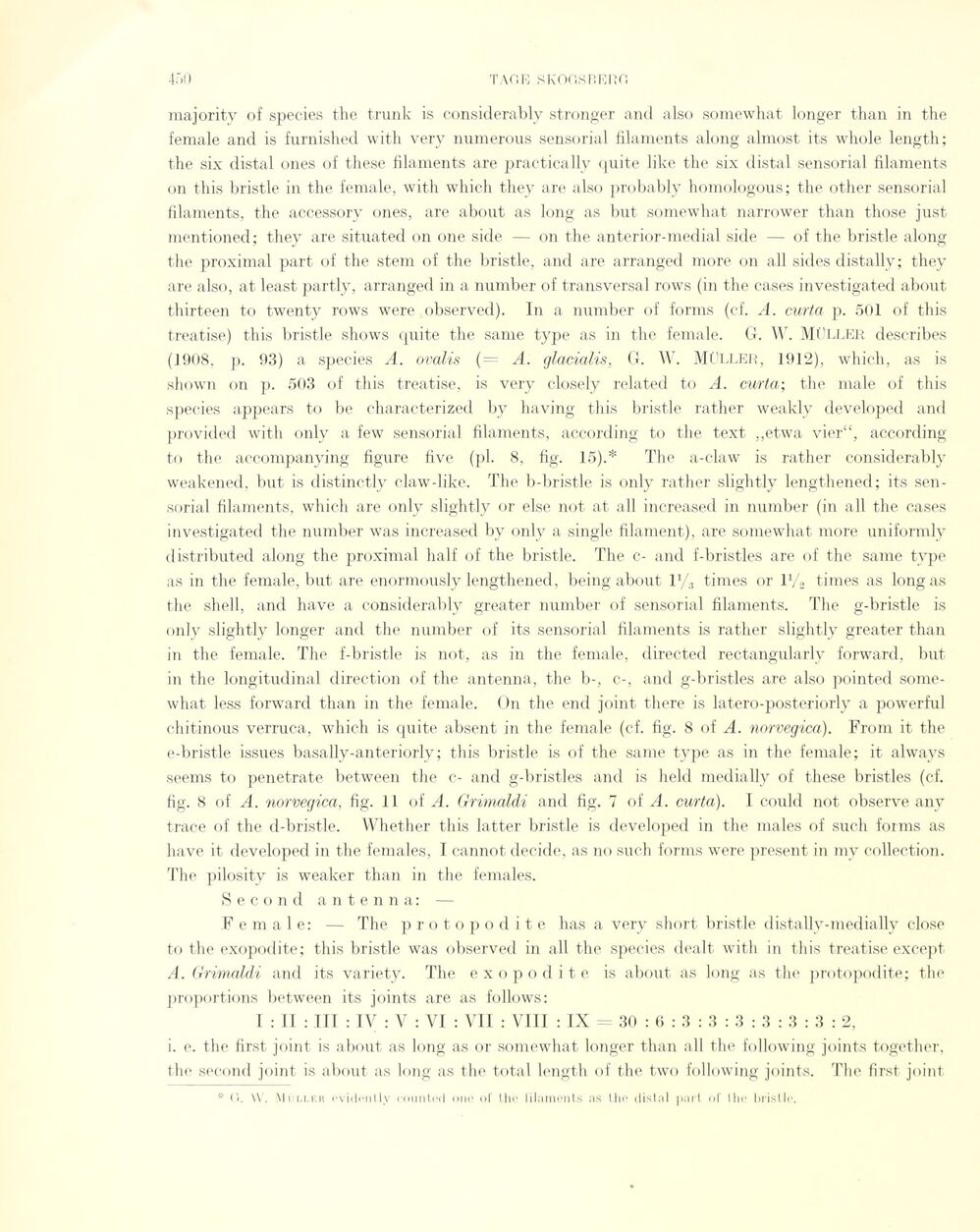
Full resolution (JPEG) - On this page / på denna sida - Sidor ...

<< prev. page << föreg. sida << >> nästa sida >> next page >>
Below is the raw OCR text
from the above scanned image.
Do you see an error? Proofread the page now!
Här nedan syns maskintolkade texten från faksimilbilden ovan.
Ser du något fel? Korrekturläs sidan nu!
This page has never been proofread. / Denna sida har aldrig korrekturlästs.
majority of species the trunk is considerably stronger and also somewhat longer than in the
female and is furnished with very numerous sensorial filaments along almost its whole length;
the six distal ones of these filaments are practically quite like the six distal sensorial filaments
on this bristle in the female, with which they are also probably homologous; the other sensorial
filaments, the accessory ones, are about as long as but somewhat narrower than those just
mentioned; they are. situated on one side — on the anterior-medial side — of the bristle along
the proximal part of the stem of the bristle, and are arranged more on all sides distally; they
are also, at least partly, arranged in a number of transversal rows (in the cases investigated about
thirteen to twenty rows were observed). In a number of forms (cf. A. curta p. 501 of this
treatise) this bristle shows quite the same type as in the female. G. W. Müller describes
(1908, p. 93) a sjrecies A. ovalis (= A. glacialis, G. W. MÜLLER, 1912), which, as is
shown on p. 503 of this treatise, is very closely related to A. curta; the male of this
species appears to be characterized by having this bristle rather weakly developed and
provided with only a few sensorial filaments, according to the text „etwa vier“, according
to the accompanying figure tive (pl. 8, fig. 15).* The a-claw is rather considerably
weakened, but is distinctly claw-like. The b-bristle is only rather slightly lengthened; its
sensorial filaments, which are only slightly or else not at all increasecl in number (in all the cases
investigated the number was increasecl by only a single filament), are somewhat more uniformly
distributed along the proximal half of the bristle. The c- and f-bristles are of the same type
as in the female, but are enormously lengthened, being about iy3 times or lx/2 times as long as
the shell, and have a considerably greater number of sensorial filaments. The g-bristle is
only slightly longer and the number of its sensorial filaments is rather slightly greater than
in the female. The f-bristle is not, as in the female, directed rectangularly forward, but
in the longitudinal direction of the antenna, the b-, c-, and g-bristles are also pointed
somewhat less forward than in the female. On the end joint there is latero-posteriorly a power ful
chitinous verruca, which is quite absent in the feniale (cf. fig. 8 of A. norvegica). From it the
e-bristle issues basally-anteriorly; this bristle is of the same type as in the female; it always
seems to penetrate between the c- and g-bristles and is held medially of these bristles (cf.
fig. 8 of A. norvegica, fig. 11 of A. Grim,aldi and fig. 7 of A. curta). I could not observe any
trace of the d-bristle. Whether this latter bristle is developed in the males of such forms as
have it developed in the females, I cannot decide, as no such forms were present in my collection.
The pilosity is weaker than in the females.
Second antenna: —
Female: — The protopodite has a very short bristle distally-medially close
to the exopodite; this bristle was observed in all the species dealt with in this treatise except
A. Grimaldi and its variety. The exopodite is about as long as the protopodite; the
proportions between its joints are as follows:
I : II : TIT : IV : Y : VI : VII : VIII : IX = 30 : 6 : 3 : 3 : 3 : 3 : 3 : 3 : 2,
i. e. the first joint is about as long as or somewhat longer than all the following joints together,
the second joint is about as long as the total length of the two following joints. The first joint
* (i. \\. MCu.eh evidently eounted one of the filaments as the distal part. of the bristle.
<< prev. page << föreg. sida << >> nästa sida >> next page >>